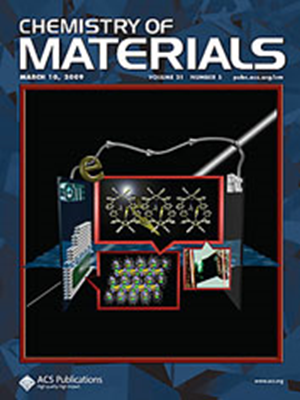在通往导电溶液可加工纳米膜的道路上,使fret成为有序向列型液晶
IF 7
2区 材料科学
Q2 CHEMISTRY, PHYSICAL
引用次数: 0
摘要
随着对大面积溶液可加工有机半导体的需求不断增加,任何电荷输运系统的高结构秩序都需要同时补充灵活性,以在器件中形成均匀的薄膜,特别是在其电极界面上实现电荷载流子的提取。因此,在不妨碍其导电性的情况下,接近向列相中间相来诱导有机电荷传输层中的流体特性是至关重要的。在此背景下,我们设计了一种发光盘状液晶(DLC)二元分子工程,以调整其自组装以促进室温下柱状向列相(NCol),平衡有序柱状超结构的二分类与向列相的动态性。合理整理的光物理、理论和电化学研究表明,在激发态,主要受低重组能的影响,施主和受主单位控制着电子相互作用和能量传递。由于这种独特的有序向列相呈现无缺陷的溶液可加工纳米膜,DLC适合在环境条件下制造高度稳定的纳米级器件。NCol DLC纳米膜在溶液可加工垂直传输器件中表现出显著的电荷提取特性,电导率为10-4 S m-1,这一报告对DLC中有序向列相的自组装和电荷传导的知识做出了开创性的贡献。本文章由计算机程序翻译,如有差异,请以英文原文为准。

A FRET-Enabled Ordered Nematic Liquid Crystal en Route to Electrically Conductive Solution-Processable Nanofilms
With the rising demand for large-area solution-processable organic semiconductors, the high structural order of any charge-transport system needs to be supplemented with simultaneous flexibility to form uniform films in devices, especially to effectuate charge carrier extraction at its electrode interfaces. Hence, approaching nematic mesophases to induce fluidic properties in an organic charge-transport layer, without hindering its electrical conduction properties, assumes the utmost importance. In this context, we design a luminescent discotic liquid crystal (DLC) dyad molecularly engineered to tune its self-assembly to facilitate a columnar nematic (NCol) phase at room temperature, balancing the dichotomy of ordered columnar superstructures with the dynamicity of a nematic phase. Rationally collated photophysical, theoretical, and electrochemical studies demonstrate that the constituent donor and acceptor units govern electronic interactions and energy transfer in the excited state, predominantly influenced by low reorganization energies. With this uniquely ordered nematic phase rendering defect-free solution-processable nanofilms, the DLC was suited to fabrication of highly stable nanoscale devices under ambient conditions. Exhibiting a remarkable charge-extraction property in its undoped native state with an electrical conductivity of 10–4 S m–1, this report of a NCol DLC nanofilm in solution-processable vertical-transport devices is a pioneering contribution to the knowledge of self-assembly and charge conduction of ordered nematic phases in DLCs.
求助全文
通过发布文献求助,成功后即可免费获取论文全文。
去求助
来源期刊

Chemistry of Materials
工程技术-材料科学:综合
CiteScore
14.10
自引率
5.80%
发文量
929
审稿时长
1.5 months
期刊介绍:
The journal Chemistry of Materials focuses on publishing original research at the intersection of materials science and chemistry. The studies published in the journal involve chemistry as a prominent component and explore topics such as the design, synthesis, characterization, processing, understanding, and application of functional or potentially functional materials. The journal covers various areas of interest, including inorganic and organic solid-state chemistry, nanomaterials, biomaterials, thin films and polymers, and composite/hybrid materials. The journal particularly seeks papers that highlight the creation or development of innovative materials with novel optical, electrical, magnetic, catalytic, or mechanical properties. It is essential that manuscripts on these topics have a primary focus on the chemistry of materials and represent a significant advancement compared to prior research. Before external reviews are sought, submitted manuscripts undergo a review process by a minimum of two editors to ensure their appropriateness for the journal and the presence of sufficient evidence of a significant advance that will be of broad interest to the materials chemistry community.
 求助内容:
求助内容: 应助结果提醒方式:
应助结果提醒方式:


